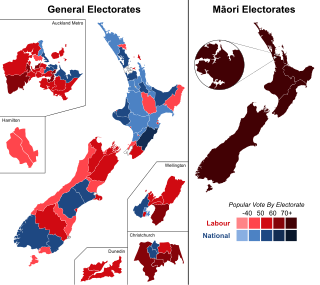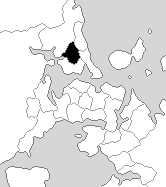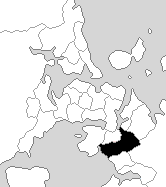Related Research Articles

The 1972 New Zealand general election was held on 25 November to elect MPs to the 37th session of the New Zealand Parliament. The Labour Party, led by Norman Kirk, defeated the governing National Party.

The 1969 New Zealand general election was a nationwide vote to determine the shape of Parliament's 36th term. It saw the Second National Government headed by Prime Minister Keith Holyoake of the National Party win a fourth consecutive term.
Albany was a New Zealand electorate. It was located in north Auckland, and named after the suburb of Albany. It existed from 1978 to 1984, and then was reinstated in 1987 before its final abolition in 2002.

Waitakere was a parliamentary electorate, returning one Member of Parliament to the New Zealand House of Representatives. The electorate was first formed for the 1946 election and existed until 2014, with breaks from 1969 to 1978 and from 1987 to 1993. The last MP for Waitakere was Paula Bennett of the National Party, who had held this position since the 2008 election.
Hauraki is a former New Zealand parliamentary electorate, from 1928 to 1987 and 1993 to 1996. In the 1987 general election it was renamed Coromandel, the name that had been used from 1972 to 1981. In 1993 it reverted to Hauraki, but became Coromandel again for the first MMP election in 1996.
Hamilton is a former New Zealand parliamentary electorate that existed from 1922 to 1969. The electorate covered the urban area of the city of Hamilton. In 1969, the city was part of two rural electorates, Hamilton East and Waikato. For the 1972 election, the nature of Hamilton East changed to urban, and the Hamilton West electorate complements it to form a second urban electorate.
Raglan is a former New Zealand parliamentary electorate. It existed for three periods between 1861 and 1996 and during that time, it was represented by 13 Members of Parliament.
Waimarino was a New Zealand parliamentary electorate that existed from 1911 to 1954, and from 1963 to 1972. It was rural in nature and was represented by four Members of Parliament.

Panmure is a former New Zealand parliamentary electorate in the southern suburbs of the city of Auckland, from 1984 to 1996. In the four parliamentary terms of its existence, it was first represented by Bob Tizard of the Labour Party, and then by his daughter Judith Tizard.
Franklin was a rural New Zealand parliamentary electorate. It existed from 1861 to 1996 during four periods.

Onehunga, initially with the formal name of Town of Onehunga, is a former New Zealand parliamentary electorate in the south of the city of Auckland. Between 1861 and 1881, and between 1938 and 1996, it was represented by seven Members of Parliament. It was a stronghold for the Labour Party.

Glenfield was a New Zealand parliamentary electorate for four terms, from 1984 to 1996. It was represented by two members of parliament, first Judy Keall of the Labour Party, and then Peter Hilt of the National Party. Hilt defected to United New Zealand in 1995.

Birkenhead was a New Zealand Parliamentary electorate on Auckland's North Shore from 1969 to 1996, when it was absorbed into the Northcote electorate.

Otara was a New Zealand parliamentary electorate in Auckland, from 1984 to 1996. It existed for four parliamentary terms and was represented by three members of parliament, two from Labour and one from National.
Pahiatua is a former New Zealand parliamentary electorate in the Wairarapa region. It existed from 1896 to 1996, and was represented by nine Members of Parliament, including Prime Minister Keith Holyoake for 34 years.
West Coast is a former New Zealand Parliamentary electorate, from 1972 to 1996.
Ruahine is a former New Zealand parliamentary electorate, from 1972 to 1978.
West Auckland is a former New Zealand parliamentary electorate on the western outskirts of Auckland, created for the 1984 election from part of the former Helensville electorate. The electorate was abolished for the 1993 election, and split between Henderson and Waitakere electorates.

Papatoetoe is a former New Zealand parliamentary electorate, and is part of greater Auckland.
Ponsonby was a parliamentary electorate in Auckland, New Zealand from 1887 to 1890 and from 1946 to 1963. The Ponsonby electorate was represented by two Members of Parliament.
References
- McRobie, Alan (1989). Electoral Atlas of New Zealand. Wellington: GP Books. ISBN 0-477-01384-8.
- Norton, Clifford (1988). New Zealand parliamentary election results, 1946–1987. Wellington: Victoria University of Wellington Department of Political Science. ISBN 0-475-11200-8.
- Wilson, James Oakley (1985) [First published in 1913]. New Zealand Parliamentary Record, 1840–1984 (4th ed.). Wellington: V.R. Ward, Govt. Printer. OCLC 154283103.